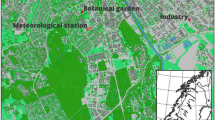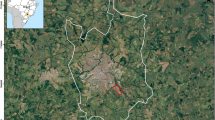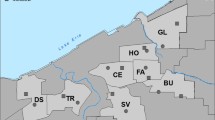Abstract
Environmentally friendly biological mosquito control by Bacillus thuringiensis var. israelensis formulations needs appropriate breeding maps. The mapping accuracy depends on the quality of the used remote sensing data. Further, the mapping is expected to be cost-effective. Our aim was to study the effect of the quality of various remote sensing data on the applicability of the maps. We depicted larval habitats by manual interpretation in Quantum GIS 3.16.1 software using remote sensing data of SENTINEL, Google Earth, commercial geoTIFF RGB orthophoto, individual unoccupied aerial systems (UAS) RGB, and multispectral mosaics. Based on our results, after classification of the target area by sorting, mixed-use of remote sensing data is required to achieve a highly cost-efficient mapping: RGB aerial photographs with 0.5 m per pixel resolution can be used efficiently in areas dominated by grassland habitats, while forest areas need customised footage taken by UAS or drones during the foliage-free period (15 cm per pixel resolution, multispectral technique). Our cost–benefit analysis showed that the aim-optimised method could reduce investment to 6–8% and the cost of data collection to 20–50% of the highest budget. This result is significant for all participants of biological mosquito control.




Similar content being viewed by others
Data availability
The datasets generated during and/or analysed during the current study are available from the corresponding author on reasonable request.
References
Reunala, T., Brummer-Korvenkontio, H., & Palosuo, T. (1994). Are we really allergic to mosquito bites? Annals of Medicine, 26, 301–306. https://doi.org/10.3109/07853899409147906
Mushinzimana, E., Munga, S., Minakawa, N., Li, L., Feng, C. C., Bian, L., Kitron, U., Schmidt, C., Beck, L., Zhou, G., Githeko, A. K., & Yan, G. (2006). Landscape determinants and remote sensing of Anopheline mosquito larval habitats in the western Kenya highlands. Malaria Journal, 5, 13–23. https://doi.org/10.1186/1475-2875-5-13
Ali, S. A., & Ahmad, A. (2018). Using analytic hierarchy process with GIS for Dengue risk mapping in Kolkata Municipal Corporation, West Bengal, India. Spatial Information Research, 26, 449–469. https://doi.org/10.1007/s41324-018-0187-x
Ghosh, S., Dinda, S., Das Chatterjee, N., Das, K., & Mahata, R. (2019). The spatial clustering of dengue disease and risk susceptibility mapping: An approach towards sustainable health management in Kharagpur city, India. Spatial Information Research, 27, 187–204. https://doi.org/10.1007/s41324-018-0224-9
Ali, S. A., & Ahmad, A. (2019). Mapping of mosquito-borne diseases in Kolkata Municipal Corporation using GIS and AHP based decision making approach. Spatial Information Research, 27, 351–372. https://doi.org/10.1007/s41324-019-00242-8
Haas-Stapleton, E., & Rochlin, I. (2022). Wetlands and mosquito control in the twenty-first century. Wetlands Ecology and Management, 30, 899–905. https://doi.org/10.1007/s11273-022-09860-w
Dworrak, T. V., Sauer, F. G., & Kiel, E. (2022). Wetland conservation and its effects on mosquito populations. Wetlands, 42, 96. https://doi.org/10.1007/s13157-022-01613-y
Zhao, T. Y., & Xue, R. D. (2022). Integrated mosquito management in rice field in China. Wetlands Ecology and Management, 30, 963–973. https://doi.org/10.1007/s11273-021-09840-6
Pope, K. O., Rejmankova, E., Savage, H. M., Arredondo-Jimenez, J. I., Rodriguez, M. H., & Roberts, D. R. (1994). Remote sensing of tropical wetlands for malaria control in Chiapas, Mexico. Ecological Applications, 4, 81–90. https://doi.org/10.2307/1942117
Thomas, C. J., & Lindsay, S. W. (2000). Local-scale variation in malaria infection amongst rural Gambian children estimated by satellite remote sensing. Transactions of the Royal Society of Tropical Medicine and Hygiene, 94, 159–163. https://doi.org/10.1016/S0035-9203(00)90257-8
Hassan, A. N., & Onsi, H. M. (2004). Remote sensing as a tool for mapping mosquito breeding habitats and associated health risk to assist control efforts and development plans: a case study in Wadi El Natroun. Journal of the Egyptian Society of Parasitology, 34, 367–382.
Kenyeres, Z., Tóth, S., Sáringer-Kenyeres, T., Márkus, A., & Bauer, N. (2017). Ecology-based mapping of mosquito breeding sites for area-minimized BTI treatments. Biologia, 72, 204–214. https://doi.org/10.1515/biolog-2017-0016
Hay, S. I., Snow, R. W., & Rogers, D. J. (1998). From predicting mosquito habitat to malaria seasons using remotely sensed data: Practice, problems and perspectives. Parasitology Today, 14, 306–313. https://doi.org/10.1016/S0169-4758(98)01285-X
Barnes, C. M., & Cibula, W. G. (1979). Some implications of remote sensing technology in insect control programs including mosquitoes. Mosquito News, 39, 271–282.
Carrasco-Escobar, G., Manrique, E., Ruiz-Cabrejos, J., Saavedra, M., Alava, F., Bickersmith, S., Prussing, C., Vinetz, J. M., Conn, J. E., Moreno, M., & Gamboa, D. (2019). High-accuracy detection of malaria vector larval habitats using drone-based multispectral imagery. PLoS Neglected Tropical Diseases, 13, e0007105. https://doi.org/10.1371/journal.pntd.0007105
Hayes, R. O., Maxwell, E. L., Mitchell, C. J., & Woodzick, T. L. (1985). Detection, identification, and classification of mosquito larval habitats using remote sensing scanners in earth-orbiting satellites. Bulletin of the World Health Organisation, 63, 361–374.
Bourgeois, M. A., & Caissie, R. M. (1997). Mosquito (Culicidae) breeding habitat distribution above the Petitcodiac River causeway. Greater Moncton Pest Control Commission.
Michaelakis, A., Balestrino, F., Becker, N., Bellini, R., Caputo, B., Della Torre, A., Figuerola, J., L’Ambert, G., Petric, D., Robert, V., Roiz, D., Saratsis, A., Sousa, C. A., Wint, W. G. R., & Papadopoulos, N. T. (2021). A case for systematic quality management in mosquito control programmes in Europe. International Journal of Environmental Research and Public Health, 18, 3478. https://doi.org/10.3390/ijerph18073478
Knight, J. M., Phinn, S. R., & Dale, P. (1999). Development of an operational approach for mapping mosquito breeding sites from airborne synthetic aperture radar. Workshop. NASA PACRIM Workshop, Maui High-Performance Computing Cen., Kihei, 26–27 August, 1999
Lacaux, J. P., Tourre, Y. M., Vignolles, C., Ndione, J. A., & Lafaye, M. (2007). Classification of ponds from high-spatial resolution remote sensing: Application to Rift Valley Fever epidemics in Senegal. Remote Sensing of Environment, 106, 66–74. https://doi.org/10.1016/j.rse.2006.07.012
Schäfer, M. (2008). Mapping potential mosquito breeding sites using satellite images. Report on methodology tests. Uppsala University.
Sowilem, M. M., El-Zeiny, A. M., & Mohamed, E. S. (2019). Mosquito larval species and geographical information system (GIS) mapping of environmental vulnerable areas, Dakhla Oasis, Egypt. International Journal of Environment and Climate Change, 9, 17–28. https://doi.org/10.9734/ijecc/2019/v9i130094
Márkus, A., Kenyeres, Z., Bauer, N., Tóth, S., Sáringer-Kenyeres, T., & Gy, S. (2009). The capabilities and confines of GIS technology in the mapping of the mosquito breeding sites of the base revelation in a background pattern. Acta Geographica Silesiana, 6, 43–51.
Zou, L., Miller, S. N., & Schmidtmann, E. T. (2006). Mosquito larval habitat mapping using remote sensing and GIS: Implications of coalbed methane development and the West Nile Virus. Journal of Medical Entomology, 43, 1034–1041. https://doi.org/10.1603/0022-2585(2006)43[1034:mlhmur]2.0.co;2
Szabó, Sz., Kenyeres, Z., Bauer, N., Gosztonyi, Gy., & Sáringer-Kenyeres, T. (2008). Mapping of mosquito (Culicidae) breeding sites using predictive geographic information methods. Dissertation Comissions of Cultural Landscape - Methods of Landscape Research, 8, 255–270.
Bravo, D. T., Lima, G. A., Alves, W. A. L., Colombo, V. P., Djogbénou, L., Pamboukian, S. V. D., Quaresma, C. C., & de Araujo, S. A. (2021). Automatic detection of potential mosquito breeding sites from aerial images acquired by unmanned aerial vehicles. Computers Environment and Urban Systems, 90, 101692. https://doi.org/10.1016/j.compenvurbsys.2021.101692
Semwal, A., Melvin, L. M. J., Mohan, R. E., Ramalingam, B., & Pathmakumar, T. (2022). AI-enabled mosquito surveillance and population mapping using dragonfly robot. Sensors, 22, 4921. https://doi.org/10.3390/s22134921
Sadiq, R., Akhtar, Z., Imran, M., & Ofli, F. (2022). Integrating remote sensing and social sensing for flood mapping. Remote Sensing Applications: Society and Environment, 25, 100697. https://doi.org/10.1016/j.rsase.2022.100697
Szabó, G., Bertalan, L., Barkóczi, N., Kovács, Z., Burai, P., & Lénárt, C. (2018). Zooming on aerial survey. In G. Casagrande, A. Sik, & G. Szabó (Eds.), Small flying drones (pp. 91–126). Springer International Publishing.
Eltner, A., & Sofia, G. (2020). Structure from motion photogrammetric technique. Developments in Earth Surface Processes, 23, 1–24. https://doi.org/10.1016/B978-0-444-64177-9.00001-1
QGIS Development Team. (2016). QGIS Geographic Information System. OpenSource Geospatial Foundation Project. http://qgis.osgeo.org
Bauer, N., & Kenyeres, Z. (2016). Élőhelytípusok és csípőszúnyog-tenyészőhelyeik bemutatása a Tisza-tó térségében [Description of habitats and mosquito breeding-sites of shallow lake Tisza-tó], In Z. Kenyeres (Ed.), A Tisza-tó térségének csípőszúnyog-faunája, tenyészőhely-térképe és a fajok élőhelyválasztása (pp. 30–34). [Mosquito fauna, breeding site map and the species requirements at shallow lake Tisza-tó.] Acta Biologica Debrecina. Supplementum Oecologica Hungarica, Debrecen (In Hungarian)
Clayton, J. S., & Sander, T. P. Y. (2002). Aerial application for control of public health pests. Aspects of Applied Biology, 66, 1–8.
Šikola, M., Chajma, P., Anděl, P., Solský, M., & Vojar, J. (2019). Finding water: Reliability of remote-sensing methods in searching for water bodies within diverse landscapes. Ecohydrology & Hydrobiology, 19, 383–392. https://doi.org/10.1016/j.ecohyd.2019.01.001
Mu, T., Liu, G., Yang, X., & Yu, Y. (2023). Soil moisture estimation based on multiple-source remote-sensing images. Remote Sensing, 15, 139. https://doi.org/10.3390/rs15010139
Boser, A., Sousa, D., Larsen, A., & MacDonald, A. (2021). Micro-climate to macro-risk: mapping fine scale differences in mosquito-borne disease risk using remote sensing. Environmental Research Letters, 16, 124014. https://doi.org/10.1088/1748-9326/ac3589
Carrasco-Escobar, G., Moreno, M., Fornace, K., Herrera-Varela, M., Manrique, E., & Conn, J. E. (2022). The use of drones for mosquito surveillance and control. Parasites & Vectors, 15, 473. https://doi.org/10.1186/s13071-022-05580-5
Bauer, N., Kenyeres, Z., Tóth, S., Sáringer-Kenyeres, T., & Sáringer, Gy. (2011). Connections between the habitat pattern and the pattern of the mosquito larval assemblages. Biologia, 66, 877–885. https://doi.org/10.2478/s11756-011-0091-5
Jansson, S., Malmqvist, E., Mlacha, Y., Ignell, R., Okumu, F., Killeen, G., Kirkeby, C., & Brydegaard, M. (2021). Real-time dispersal of malaria vectors in rural Africa monitored with lidar. PLoS ONE, 16, e0247803. https://doi.org/10.1371/journal.pone.0247803
Acknowledgements
S. Szabó was supported by the Project TKP2020-IKA-04 (National Research, Development and Innovation Fund of Hungary, financed under the 2020-4.1.1-TKP2020) funding scheme. L. Bertalan and S. Szabó were funded by the Thematic Excellence Programme (TKP2020-NKA-04) of the Ministry for Innovation and Technology in Hungary.
Author information
Authors and Affiliations
Contributions
All authors were involved in the data collection and database building. ZK, NB and SzSz formulated the main research hypotheses. LB, GSz, NB and ZK performed the analyses and drafted the manuscript. SzSz, TS-K and AM contributed to the manuscript drafting. AM, SzSz and ZK compiled the figures. All authors have read, revised, and approved the final version of the manuscript.
Corresponding author
Ethics declarations
Conflict of interest
The authors declare that they have no known competing financial interests or personal relationships that could have appeared to influence the work reported in this paper.
Additional information
Publisher's Note
Springer Nature remains neutral with regard to jurisdictional claims in published maps and institutional affiliations.
Rights and permissions
Springer Nature or its licensor (e.g. a society or other partner) holds exclusive rights to this article under a publishing agreement with the author(s) or other rightsholder(s); author self-archiving of the accepted manuscript version of this article is solely governed by the terms of such publishing agreement and applicable law.
About this article
Cite this article
Kenyeres, Z., Bauer, N., Bertalan, L. et al. Cost–benefit analysis of remote sensing data types for mapping mosquito breeding sites. Spat. Inf. Res. 31, 419–428 (2023). https://doi.org/10.1007/s41324-023-00511-7
Received:
Revised:
Accepted:
Published:
Issue Date:
DOI: https://doi.org/10.1007/s41324-023-00511-7




